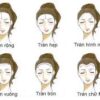Unlocking Insights: Face Reading through Eye Blinking and Eye Movements
Welcome to our website dedicated to the intriguing realm of face reading, where we delve into the significance of eye blinking and eye movements in unraveling an individual’s character and personality. Our eyes are windows to the soul, and they convey a wealth of information about a person’s thoughts, emotions, and hidden qualities.

- Eye Blinking:
Eye blinking patterns can provide valuable clues about a person’s mental and emotional state. Here are some key interpretations:
a) Rapid Blinking: Frequent rapid blinking may indicate heightened mental activity or stress. It suggests that the person is processing information or dealing with internal tension.
b) Slow Blinking: Slow blinking can convey relaxation, confidence, and a calm demeanor. It indicates a composed and unhurried nature.
c) Avoiding Eye Contact: Consistently avoiding eye contact may suggest shyness, introversion, or discomfort in social interactions. It could also indicate a desire for privacy or a lack of confidence.
- Eye Movements:
The movements of our eyes can reveal valuable insights into a person’s thought processes and focus. Here are a few notable eye movements and their meanings:
a) Eye Contact Duration: Sustained eye contact reflects attentiveness and confidence. It indicates a willingness to engage and connect with others.
b) Eye Rolling: Eye rolling can be a sign of annoyance, disbelief, or disagreement. It suggests that the person may not agree with or approve of the current situation or conversation.
c) Dilated Pupils: Dilated pupils are often associated with heightened interest or excitement. They indicate enthusiasm, curiosity, or attraction to something or someone.
- Eye Direction and Focus:
The direction in which a person’s eyes naturally move can offer insights into their thinking and information processing style. Here are a few eye direction interpretations:
a) Upward Eye Movement: Looking upward may suggest visual or imaginative thinking. It is often associated with creativity, visualization, and accessing memories.
b) Sideways Eye Movement: Looking sideways may indicate auditory thinking. It suggests that the person is processing information through sounds, voices, or internal dialogue.
c) Downward Eye Movement: Looking downward may reflect introspection, deep thought, or accessing internal feelings and emotions.
Remember that face reading provides general insights and should not be used as the sole determinant of one’s character. Each individual is unique, and it is the combination of various facial features, expressions, and gestures that contribute to their overall personality.
Seeking Professional Advice:
Face reading is an ancient art influenced by cultural beliefs and personal experiences. The interpretations provided on this website are for general understanding and should not replace professional advice or psychological assessments. If you have specific concerns or questions about eye blinking, eye movements, or non-verbal communication, it is recommended to consult with qualified professionals for a comprehensive assessment and guidance.
Explore our website to dive deeper into the captivating world of face reading and uncover the meanings behind eye blinking, eye movements, and other facial expressions. Enhance your understanding of yourself and others by embracing the power of non-verbal communication and the intricate language of the face.
Disclaimer: The information provided on this website is for educational and entertainment purposes only. It should not be used as a substitute for professional advice or psychological evaluation. Always consult with qualified professionals for any concerns or questions you may have.
Note: Face reading practices may vary across cultures and personal beliefs. The information provided on this website is a general overview and may differ from specific cultural practices or interpretations.

